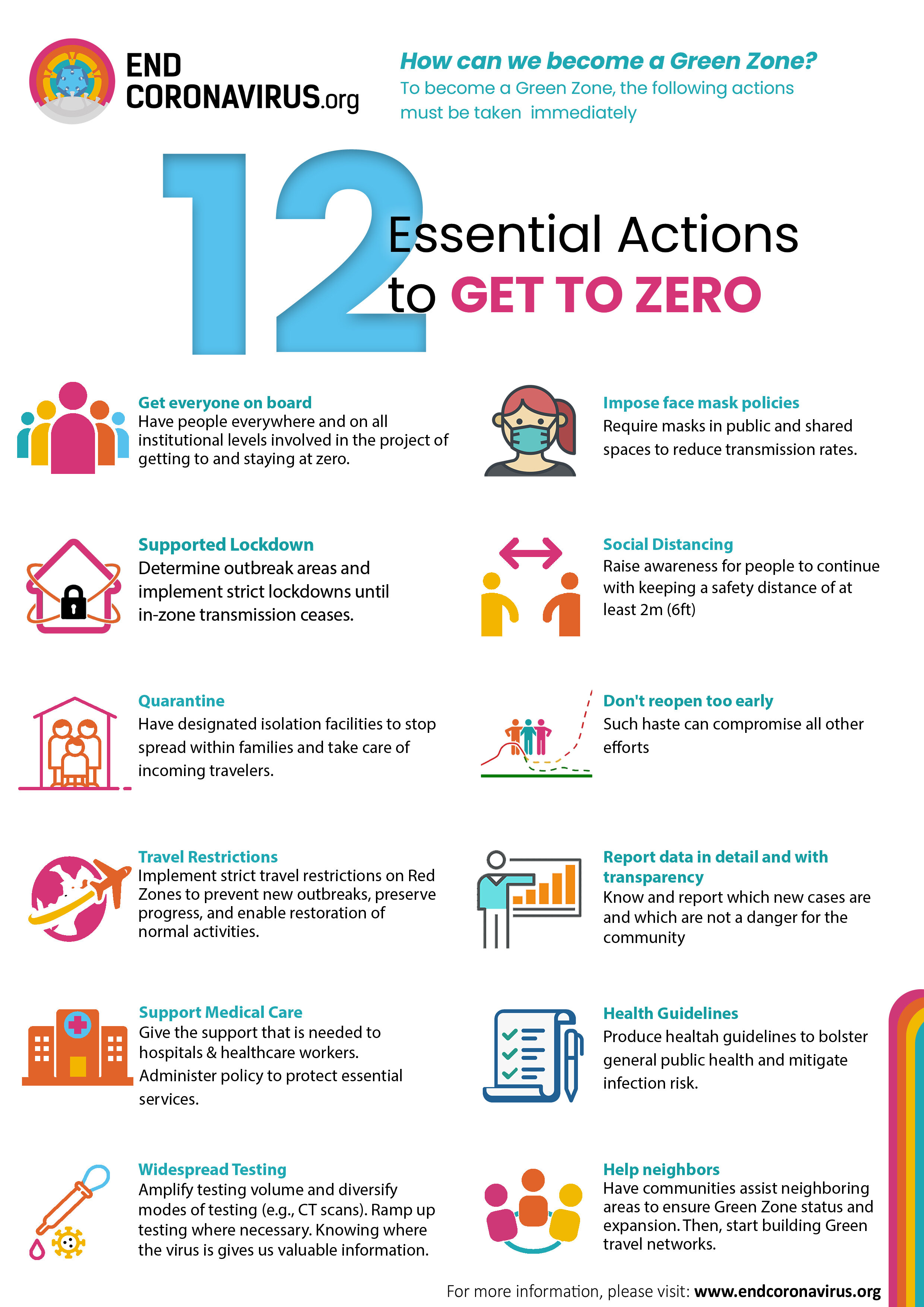Green zones
Green Zone Exit strategy: Open up areas that have zero community transmission and protect them with temporary restrictions and quarantines on non-essential travel
The goal: zero new COVID-19 cases worldwide
In a year of suffering and losses, many countries have made their own experiments in how to deal with COVID-19.
The results of these experiments are known:
- Having COVID-19 under control reduces suffering and losses.
- No country has COVID-19 under control without strong travel restrictions.
- No country has COVID-19 under control by trying to keep the numbers at a non-zero threshold.
- It is easier to get back to zero if you react fast to new outbreaks.
- It is not too late to try to get COVID-19 under control and it doesn’t take long.
Let’s learn from the countries that succeeded. Go for zero - with a green-zone strategy.
What is a green zone?
No new local transmission for 14 consecutive days
New cases only in those who were isolated upon entering the zone
No land-border with a red zone (otherwise green turns yellow)
See our FAQ for more details on zones.
Green zones save lives and the economy
Low cases vs No Cases
The differences in human and financial costs between an almost-green zone and a green zone are immense. Most importantly, for zones with more than zero cases:
Superspreader events can always lead to a second wave, resulting in many deaths, new lockdowns and other expensive measures.
A significant percentage of the high-risk group won’t feel safe enough to contribute to the economy as much as before COVID-19.
It will be harder to become part of a green-zone travel network which impacts businesses, tourism and study abroad efforts.
Green-zone Travel Networks
Connecting green zones on all levels:
From communities to countries.
What is a green-zone
travel network?
Top-down
certified green zones
Proposal to European Commission to define, administer and monitor a
“EU green label” for countries to promote and manage a Pan-European green-zone travel network
by Oliu-Barton & Pradelski
Building on trust
bottom-up
Between countries:
Within countries:
Actions to win
Act Quickly
Don’t wait for “more data” or results from complicated models. It isn’t too late to start now. The earlier you act, the earlier things can go back to normal.
Isolate away from home
Set up facilities to isolate infected individuals from their family members. Roughly 80% of transmission in Wuhan was within the home.
Strict travel restrictions
If you are in a green or yellow zone with no community transmission, impose travel restrictions on red zones and reopen the local economy. For red zones, restrict outward travel to avoid infecting others. For essential travel, have mandatory quarantines to avoid spreading the virus.
Massive amount of testing
Testing allows you to identify infected individuals and separate them from the rest of the community.
Face masks for everyone
Reducing transmission by having everyone wear a face mask is simple, cheap, and highly effective.
Continue practicing social distancing
Stay away from crowded areas and keep as much distance between nearest neighbors as possible. Those with comorbidities (the elderly, overweight, immunocompromised, etc.) should be the last to be reintroduced into society, as they are the most vulnerable.
Be patient. Don’t reopen too early
Reopening too early runs the risk of triggering exponential growth again. This might erase all of the benefits gained from the lockdown so far. It could increase the total amount of deaths, overwhelm the medical system, and create a scenario where another lockdown is necessary.
Frequently asked questions
What are zones?
A zone should be a district that is naturally or artificially separated from its neighboring districts and should only have controllable traffic transitions with neighboring zones. If two geographical regions have a shared border that cannot be effectively controlled, they should be considered as one zone.
It seems impossible to get even the smallest zone I’m in to become a green zone. What can I do as an Individual?
You can ask friends/colleagues if they would like to agree on a set of rules that allow you to form safe spaces to get/learn/work together in your community.
By sharing information and recruiting others these dynamic “green groups” can expand and/or new ones can be created independently of your own until the whole area has become virus-free.
Once an area is green, what can it do to stay green?
Strict travel restrictions, with testing and quarantines upon arrival, will help reduce the probability that imported cases create outbreaks. Continuing to test, trace, and isolate within the population is important to monitor the community and make sure they are free of Covid-19. Helping neighboring areas to become green further reduces the probability of virus reintroduction.
How do Green, yellow, & Red zones differ?
Green zone—no new local (within community) transmission for 14 consecutive days. All new cases, if any, occur in individuals who were effectively isolated from the moment they entered the zone (imported travelers)
Yellow zone—no new local transmission for 14 consecutive days, but there are new cases identified using contact tracing, or the zone is adjacent to a red zone with travel routes between them
Red zone—community transmission identified within the last 14 days
For a long time now we have been at only a few new daily cases. Shouldn’t we be at Zero by now?
It is as hard to get from 1000 cases to 100 as it is to get from 100 to 10.. If you have low cases as well as strong travel restrictions, massive testing and contract tracing in place, you are winning! Keep up the good work!




















